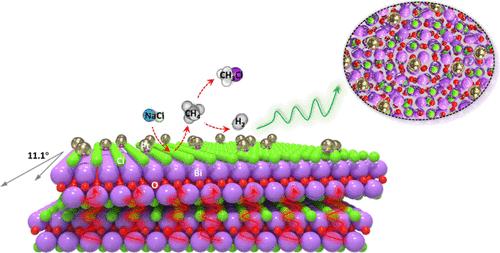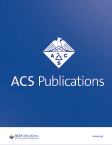Twisted BiOCl Moiré Superlattices for Photocatalytic Chloride Reforming of Methane
IF 3.784
3区 化学
Q1 Chemistry
引用次数: 0
Abstract
Solar-driven conversion of CH4 into value-added methyl chlorides and H2 with abundant chloride ions offers a sustainable CH4 reforming strategy but suffers from inefficient Cl– activation and severe e––h+ recombination in traditional photocatalysts. Herein, we demonstrate that BiOCl moiré superlattices with a 11.1° twist angle are highly efficient for photocatalytic CH4 reforming into CH3Cl and H2 with NaCl. These moiré superlattices, featuring misalignment-induced tensile strains, destabilize surface Bi–Cl bonds, facilitating a hole-mediated MvK-analogous process to activate lattice Cl into reactive •Cl for CH4 chlorination. Meanwhile, their twisted stacking configurations reinforce interlayer electronic coupling and thus accelerate out-of-plane carrier transfer. Along with surface anchoring of single-atom Pt sites for H2 evolution, the resulting Pt1/BiOCl moiré superlattices deliver a CH3Cl yield of 53.4 μmol g–1 h–1 with an impressive selectivity of 96% under visible light. This study highlights the potential of lattice engineering in two-dimensional photocatalysts to regulate structural strains and carrier dynamics for the decentralized reforming of CH4.

用于甲烷光催化氯化物转化的扭曲 BiOCl Moiré 超晶格
利用太阳能将 CH4 转化为具有丰富氯离子的高附加值甲基氯化物和 H2 提供了一种可持续的 CH4 重整策略,但传统光催化剂存在 Cl- 活化效率低和严重的 e-h+ 重组问题。在此,我们证明了具有 11.1° 扭转角的 BiOCl 摩尔超晶格可高效光催化 CH4 与 NaCl 重整为 CH3Cl 和 H2。这些摩尔超晶格具有错配诱导的拉伸应变,可破坏表面 Bi-Cl 键的稳定性,促进由空穴介导的 MvK 类似过程,将晶格中的 Cl 活化为活性 -Cl,从而实现 CH4 氯化。同时,它们的扭曲堆叠构型加强了层间电子耦合,从而加速了平面外载流子的转移。伴随着用于 H2 演化的单原子铂位点的表面锚定,由此产生的 Pt1/BiOCl 摩尔超晶格在可见光下的 CH3Cl 产率达到 53.4 μmol g-1 h-1,选择性高达 96%,令人印象深刻。这项研究强调了二维光催化剂晶格工程在调节结构应变和载流子动力学以实现 CH4 分散重整方面的潜力。
本文章由计算机程序翻译,如有差异,请以英文原文为准。
求助全文
约1分钟内获得全文
求助全文
来源期刊

ACS Combinatorial Science
CHEMISTRY, APPLIED-CHEMISTRY, MEDICINAL
自引率
0.00%
发文量
0
审稿时长
1 months
期刊介绍:
The Journal of Combinatorial Chemistry has been relaunched as ACS Combinatorial Science under the leadership of new Editor-in-Chief M.G. Finn of The Scripps Research Institute. The journal features an expanded scope and will build upon the legacy of the Journal of Combinatorial Chemistry, a highly cited leader in the field.
 求助内容:
求助内容: 应助结果提醒方式:
应助结果提醒方式:


